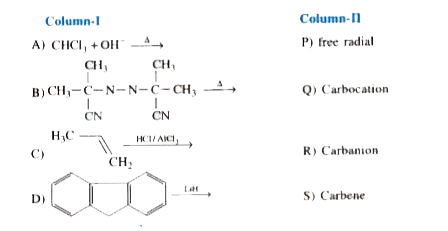Give hybridisation state of each carbon in the following molecules (a) CH2=C=CH2 and (b) CH2=CH−CH=CH1Solution in Telugu
(a) H2C=C=CH2C2 is sp hybridised
C1andC3 are sp2 hybridised
(b) H2C=CH−CH=CH2 All the carbons are in sp2 hybridisation
Topper's Solved these Questions
- GENERAL ORGANIC CHEMISTRYBOOK - AAKASH SERIESCHAPTER - GENERAL ORGANIC CHEMISTRYEXERCISE - Subjective Exercise -1
11 Videos
- GENERAL ORGANIC CHEMISTRYBOOK - AAKASH SERIESCHAPTER - GENERAL ORGANIC CHEMISTRYEXERCISE - Subjective Exercise -2
6 Videos
- ENVIRONMENTAL CHEMISTRYBOOK - AAKASH SERIESCHAPTER - ENVIRONMENTAL CHEMISTRYEXERCISE - EXERCISE ON PASSAGE (PASSAGE-III)
5 Videos
- HYDROCARBONSBOOK - AAKASH SERIESCHAPTER - HYDROCARBONSEXERCISE - ADDITIONAL PRACTICE SHEET ( LEVEL-II (PRACTICE SHEET (ADVANCED) (MATRIX MATCHING TYPE QUESTIONS)))
5 Videos
Similar Questions
Explain the structures of CH4andC2H6.
View SolutionExplain the classification of hydrocarbons.
View SolutionOzone layer acts as one of the most important life support system. The major cause of ozone layer destruction is believed to be the release of chlorofluorocarbon compounds. UV radiation causes the chlorofluouocarbons to dissociate : CF2Clhv−−→Cl⋅+CF2CI A highly reactive chlorine atomis responsible for the decomposition of ozone. Cl⋅+O3(g)→ClO⋅+O2(g)ClO⋅+O(g)→Cl⋅+O2(g) Free radicals of chlorine decompose ozone molecules in a chain reaction. The depletion of ozone layer leading to ozone hole has, however, been mainly observed in the stratosphere over Antarctica. Special type of cloud called polar stratospheric colouds are formed over Antarctica.These clouds (contain solid HNO3.3H2O) play an important role in ozone depletion.
ClO⋅+NO2→ClONO2
ClONO2+H2O→HOCl+HNO3
ClONO2+HCl→Cl2+HNO3
HOClhv−−→HO⋅+Cl⋅
The reactive chlorine atoms thus formed are rendered to deplete ozone layer.
The ozone layer is present in :
View SolutionMatch the intermediates formed in the reaction.

View SolutionName of the following as substituted derivatives of ethylene.
(a) CH3−CH=CH−CH3
(b) CI2C=CHCI
(c) (CH3)2C=CH2
(d) (CH2=CH)2C=CH2
(e) (CH2=CH)−CH=CH−(CH=CH2)
View SolutionMention the state of hybridisation of all the carbon atoms in he molecule CH_(2)=CH-CH=CH_(2)
View SolutionIndicate the type of hybridization of each carbon atom in the following molecules: (i) CH_(3)-C-=CH-CH_(3) (ii) H_(2)C=C=CH_(2) (iii) CH_(3)-CH=CH-CH_(3) (iv) CH_(3)-CH_(2)-CH_(3)
View SolutionHybridisation of carbonium carbon in CH_(3)^(+),CH_(3)^(-)" and "CH_(2)=CH-overset(-)CH_(2) carbons are :
View SolutionWhat are hybridisation states of each carbon atom
in the following compounds ?
CH2=C=O,CH3CH=CH2,(CH3)2CO,<br>CH2=CHCN,C6H6.
View SolutionCH3 ∣CH3−CH−CH−CH−CH2−CH2 | | CH2−ClCH3
locants at parent carbon chain will be :-
View SolutionIdentify the state of hybridisation of each carbon in: (i) CH_(2)=CH-CH=CH_(2) (ii) CH_(2)=C=CH_(2) (iii) CH_(3)-C-=CH ltBrgt (iv) CH_(2)=CH-CHO (v) HC-=C-CHO
View SolutionWhat are hybridisation states of each carbon atom in the following compounds ? CH2=C=O,CH3CH=CH2, (CH3)2CO, CH2=CHCN and HCONH2
View SolutionMention the state of hybridisation of the carbon atoms present in the molecule, CH_(3)CH=C=CHCH_(2)CH_(3) .
View SolutionWhat are hybridisation states of each carbon atom in the following compounds?
CH2=C=O,CH3CH=CH2,(CH3)2CO,CH2=CHCN,C6H6
View SolutionIn the hydrocarbon CH3−CH2−CH=.CH−CH2−C≡CH the state of hybridisation of carbon 1,2,3,4 and 7 are in the following sequence.
View Solution
